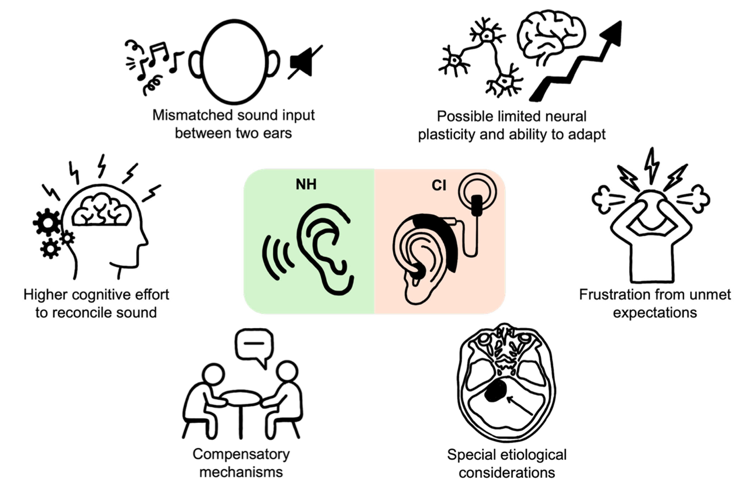By Subong Kim, Ph.D.
Like noise canceling options available in most headphones, hearing aids are also equipped with multiple noise reduction (NR) features with varying signal processing strengths to help listen in noisy environments.
As the name suggests, NR attenuates noise levels, but unfortunately it often affects speech cues that may overlap with background noise, lowering sound quality. Consequently, some hearing aid users may find NR processing favorable as it noticeably reduces noise, while others may find it unfavorable as it leads to a decline in speech quality.
The degree of individual variability can become tremendous with the increasing strength of NR processing, where more noise is reduced, but speech quality worsens. This variability may stem from individual characteristics such as noise tolerance.
Illustration of how noise reduction (NR) algorithms affect speech and noise. (A) Compares the power levels of speech (solid line) and noise (dotted line) for two NR settings. (B) Shows how similar the speech signals are with NR on versus off across different frequencies. Credit: Kim et al./Applied Sciences
Our research aims to better understand the underlying biological mechanisms of such variability and pave the way for a more personalized and effective hearing aid technology, offering hope for those struggling in noisy listening environments.
Before we delve into the details of our experiment, it is essential to note that the concept of signal-to-noise ratio is a fundamental aspect of understanding sound perception. It is the numerical representation of the balance between signal (the sound we want to hear, like speech) and noise (the sound we do not).
For instance, when a sound has a signal-to-noise ratio of 3 decibels (dB), the perception of the sound could be vastly different internally between two individuals, with one perceiving 0 dB and the other perceiving 6 dB.
To overcome this, our team has quantified an individual “neural signal-to-noise ratio” using brain measures with electrodes attached to the human scalp. Our data reveals that this brain index can predict the extent of speech perception benefits from NR in each listener. In addition, this correlation becomes more pronounced with the increasing strength of NR processing, underscoring the practicality of this biological measure.
One distinct part of our experiments is that we also included subjective measures of noise tolerance in the test battery to compare an individual’s answers about noise tolerance on questionnaires with what their brain shows during the experiments. Both measures collectively better explain individual variability in NR benefits in speech perception—even though the brain and subjective measures did not correlate and the portion explained by the subjective measure was marginal.
These findings, which appeared in the journal Applied Sciences in August 2024, are significant. Our results suggest that objective measures such as brain measures and people's responses to survey questions may capture different perspectives of their auditory characteristics. We will continue incorporating subjective and biological measures and investigate the underlying biological mechanisms of people's reactions to hearing aid features such as NR.
Many studies in this area are currently being conducted in the Hearing Outcome and Neuroscience Laboratory, part of the department of communication sciences and disorders at Montclair State University in New Jersey. We look forward to sharing more results from our research.
A 2022–23 Emerging Research Grants scientist, Subong Kim, Ph.D., is an assistant professor of audiology in the department of communication sciences and disorders at Montclair State University.








What moved me most was not just the science. It was the joy. I will never forget an older man who heard his grandson’s voice clearly for the first time in years.